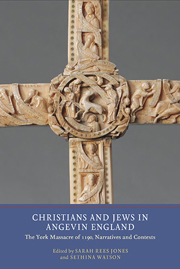Book contents
- Frontmatter
- Contents
- List of Illustrations
- Contributors
- Editor's Preface and Acknowledgments
- Abbreviations
- Introduction: The Moment and Memory of the York Massacre of 1190
- Part I The Events of March 1190
- 1 Neighbours and Victims in Twelfth-Century York: a Royal Citadel, the Citizens and the Jews Of York
- 2 Prelude and Postscript to the York Massacre: Attacks in East Anglia and Lincolnshire, 1190
- 3 William of Newburgh, Josephus and the New Titus
- 4 1190, William Longbeard and the Crisis of Angevin England
- 5 The Massacres of 1189-90 and the Origins of the Jewish Exchequer, 1186–1226
- Part II Jews among Christians in Medieval England
- Part III Representations
- Afterword: Violence, Memory and the Traumatic Middle Ages
- Bibliography
- Index
- York Medieval Press: Publications
4 - 1190, William Longbeard and the Crisis of Angevin England
from Part I - The Events of March 1190
Published online by Cambridge University Press: 05 May 2013
- Frontmatter
- Contents
- List of Illustrations
- Contributors
- Editor's Preface and Acknowledgments
- Abbreviations
- Introduction: The Moment and Memory of the York Massacre of 1190
- Part I The Events of March 1190
- 1 Neighbours and Victims in Twelfth-Century York: a Royal Citadel, the Citizens and the Jews Of York
- 2 Prelude and Postscript to the York Massacre: Attacks in East Anglia and Lincolnshire, 1190
- 3 William of Newburgh, Josephus and the New Titus
- 4 1190, William Longbeard and the Crisis of Angevin England
- 5 The Massacres of 1189-90 and the Origins of the Jewish Exchequer, 1186–1226
- Part II Jews among Christians in Medieval England
- Part III Representations
- Afterword: Violence, Memory and the Traumatic Middle Ages
- Bibliography
- Index
- York Medieval Press: Publications
Summary
The brief life and abortive revolutionary career of William FitzOsbert, alias William Longbeard, came to a sad end, if our sources are to be believed, in a mad insurrection against the royal and municipal authorities in London in April 1196. His brief moment of fame or infamy can be used as a window into many aspects of late twelfth century culture. His life throws light on the experience of crusading and the possibly traumatic effects it could have; on the plight of the poor in a newly urbanized and monetarized society; and on the politics of London and of England as a whole. Indeed, a comparison of the events surrounding the massacre in York in 1190 and the events surrounding FitzOsbert's death provides a window into the tensions of Angevin England. This chapter will therefore consist of three parts. First, I provide a very brief narrative of the events of April 1196. Then I offer an extremely basic compare-and-contrast exercise between FitzOsbert's demise and the events of March 1190; and finally, I suggest what that comparison can say about the nature of English society in the 1190s.
Let me begin with a brief narrative of FitzOsbert's life. William FitzOsbert, the younger son of a rich London family, is first recorded as a participant on the Third Crusade. Following the example of a previous generation of Londoners, he joined with some fellow citizens to fit out a ship as a communal undertaking.
- Type
- Chapter
- Information
- Christians and Jews in Angevin EnglandThe York Massacre of 1190, Narratives and Contexts, pp. 91 - 105Publisher: Boydell & BrewerPrint publication year: 2013

